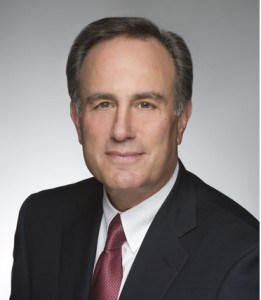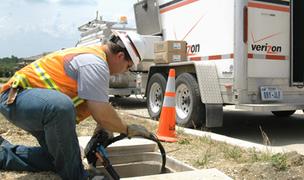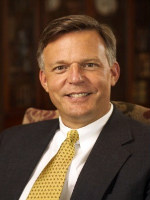 California’s Public Utilities Commission (CPUC) couldn’t get cozier with AT&T if they moved regulators into the phone company’s plush executive suites.
California’s Public Utilities Commission (CPUC) couldn’t get cozier with AT&T if they moved regulators into the phone company’s plush executive suites.
In a 3-2 decision, the CPUC has given California phone companies that cannot manage to keep their wireline networks in good order an early Christmas, allowing the companies to effectively fine themselves for bad performance and keep the money.
Although the CPUC adopted a series of “automatic fines” for companies with chronic service problems (AT&T is by far the largest offender), it completely negated any sting by allowing companies to skip the fine by demonstrating they’ve invested at least twice the amount of the penalty in their networks. That is an expense AT&T’s bookkeepers can manage to document in minutes just by highlighting AT&T’s investments in other parts of the state. AT&T can argue investments in gigabit fiber in southern California or wiring fiber to business parks and cell sites improves service reliability for at least some customers.
CPUC president Michael Picker isn’t in any hurry either, helpfully offering AT&T and other phone companies two years to complete the investments that will cancel their fines:
In support of a request to suspend the fine, carriers may propose, in their annual fine filing, to invest no less than twice the amount of their annual fine in a project (s) which improves service quality in a measurable way within 2 years. The proposal must demonstrate that 1) twice the amount of the fine is being spent, 2) the project (s) is an incremental expenditure with supporting financials (e.g. expenditure is in excess of the existing construction budget and/or staffing base), 3) the project (s) is designed to address a service quality deficiency and, 4) upon the project (s) completion, the carrier shall demonstrate the results for the purpose proposed. Carriers are encouraged to review their service quality results to find appropriate target projects to invest funds.
Consumer advocates have accused AT&T of underinvesting in their wireline facilities for years. Because the CPUC does not require the investment be specifically targeted to correcting problems that prompted the fine, phone companies can continue to allow high cost/low profit rural infrastructure to deteriorate while targeting service-improving investments in more profitable or competitive service areas.
Steve Blum from Tellus Venture Associates, who has closely tracked telecom public policy matters in California for years, called it the most cynical decision he’s ever seen from the CPUC:
Fines, it seems, are just another cost of doing business for telecoms companies and don’t matter anyway. So why not let them keep the money?
Boiled down, that’s CPUC president Michael Picker’s rationale for establishing new telephone voice service level requirements backed up by a swinging schedule of penalties and then saying but we’ll let you keep the money if you invest it in infrastructure or pay staff. Or something. Anything.

Picker
Commissioner Mike Florio called the Picker’s proposal “unenforceable.”
The CPUC’s own staff has documented the troubling condition of landline service in the state. A staff report published in September 2014 showed the largest phone companies in the state — AT&T and Verizon (later sold to Frontier Communications) — that control 88% of landlines in California never met the CPUC’s minimum standard of repairing 90% of “out of service” trouble tickets within 24 hours during 2010-2013.
In 2010 and 2011, AT&T and Verizon needed an average of 110 hours to repair 90% of outages. That is 4.5 days. In 2012 and 2013, repair time marginally improved to an average of 72 hours (3 days). That is three days without any phone service or the ability to call 911, something the CPUC staff said compromised public safety.
AT&T and Verizon have papered the CPUC’s walls with “corrective action reports” over the years explaining why they failed to meet CPUC standards and what actions they planned to take to improve compliance. The staff report found those reports never resulted in improved compliance.
Commissioner Catherine Sandoval submitted an alternative plan of simple fines and a reporting system that gives equal weight to outages occurring in areas served by independent phone companies like Citizens Telecommunications Company of California (d/b/a Frontier) and SureWest Telephone (d/b/a Consolidated Telephone). Picker didn’t bother to hold a vote on Sandoval’s proposal, instead bringing his own proposal to the commission that approved it on a 3-2 voice vote. Florio and Sandoval voted no.
Despite the easy out, the state’s phone companies are still complaining the fine system was unnecessary because the free market was best equipped to manage service outages. If customers don’t like their provider, they can switch, assuming there is another provider available in the large rural and mountainous parts of the state.


 Subscribe
Subscribe AT&T has gone over the top donating at least $70,000 to back Republican House Speaker Paul Ryan, more than the company has ever donated to anyone else.
AT&T has gone over the top donating at least $70,000 to back Republican House Speaker Paul Ryan, more than the company has ever donated to anyone else.
 It wasn’t difficult to understand Verizon’s sudden reticence about continuing its fiber to the home expansion program begun under the leadership of its former chairman and CEO Ivan Seidenberg. Starting his career with Verizon predecessor New York Telephone as a cable splicer, he worked his way to the top. Seidenberg understood Verizon’s wireline future as a landline phone provider was limited at best. With his approval, Verizon began retiring decades-old copper wiring and replaced it with fiber optics, primarily in the company’s biggest service areas and most affluent suburbs along the east coast. The service was dubbed FiOS, and it has consistently won high marks from customers and consumer groups.
It wasn’t difficult to understand Verizon’s sudden reticence about continuing its fiber to the home expansion program begun under the leadership of its former chairman and CEO Ivan Seidenberg. Starting his career with Verizon predecessor New York Telephone as a cable splicer, he worked his way to the top. Seidenberg understood Verizon’s wireline future as a landline phone provider was limited at best. With his approval, Verizon began retiring decades-old copper wiring and replaced it with fiber optics, primarily in the company’s biggest service areas and most affluent suburbs along the east coast. The service was dubbed FiOS, and it has consistently won high marks from customers and consumer groups.


 Verizon Communications is taking the New York Public Service Commission to court over the regulator’s ruling that $8 million in property tax refunds rebated to the phone company through a tax certiorari proceeding should be spent on improving Verizon’s service quality in the state.
Verizon Communications is taking the New York Public Service Commission to court over the regulator’s ruling that $8 million in property tax refunds rebated to the phone company through a tax certiorari proceeding should be spent on improving Verizon’s service quality in the state. Verizon calls the regulator’s demands arbitrary and unwarranted confiscation of its property.
Verizon calls the regulator’s demands arbitrary and unwarranted confiscation of its property. An AT&T executive casually told an audience attending the Wells Fargo 2016 Convergence & Connectivity Symposium that a significant part of
An AT&T executive casually told an audience attending the Wells Fargo 2016 Convergence & Connectivity Symposium that a significant part of 
